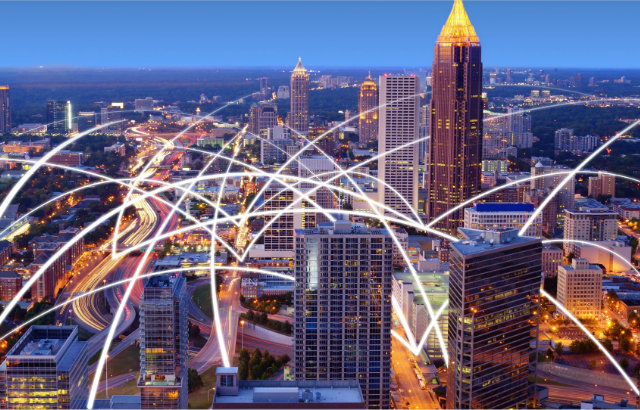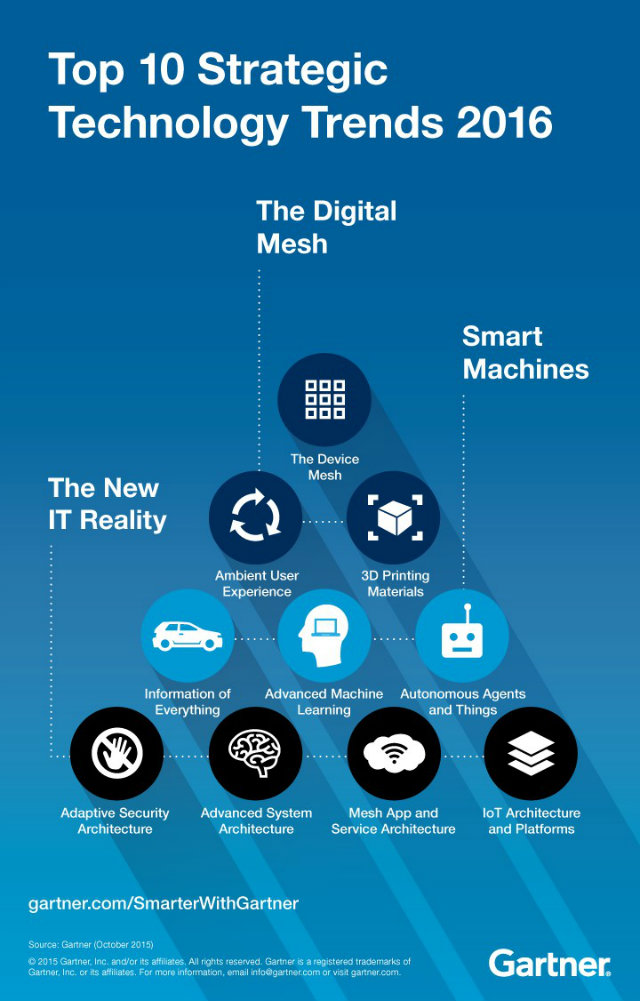
"My interest is in the future because I am going to spend the rest of my life there." (C.F. Kettering)
What technologies will impact organizations from 2016 on? As the end of year approaches, it is natural to look back at the highlights of the past. If you are an innovative digital leader, though, you will agree that it is way more useful to look ahead and try to foresee what is going to happen next.
That is exactly what Gartner’s analysts do every year, tracing the main technology trends that will define the borders of business transformation for the next future. As usual in the digital era, evolution is all about disruption.
First of all, what kind of trends should be considered in this list? Gartner defines a strategic technology trend as “one with the potential for significant impact on the organization. Factors that denote significant impact include a high potential for disruption to the business, end users or IT, the need for a major investment, or the risk of being late to adopt.”
These technologies are very different but they share a common trait: they impact the company's long-term development plans, customer experience programs and marketing initiatives.
Last year, in this very same period, we were discussing the 2015 release of Gartner’s technology report. The innovative trends traced could be divided into three major areas of interest:
- The merging of the real and virtual worlds;
- The advent of intelligence everywhere;
- The technology impact of the digital business shift.
Some trends were already evident at the time of the release, others were still in nuce or ready to explode. In a customer’s perspective, all of them had the potential to change forever the way companies define their digital customer experience and build meaningful connections.
Of course, one year is not enough to show the real potential of complex disruptive devices (i.e. this is the case of context-rich systems, the Internet of Things and smart machines). To some extent, the real effects will be fully displayed in the next five years or so. If you want to know more, just take a look at our in-depth analysis.
Now it is time to focus on the newly-released report about Gartner’s Top 10 Technology Trends for 2016. In the words of David Cearley, vice president and Gartner Fellow:
"Gartner's top 10 strategic technology trends will shape digital business opportunities through 2020. The first three trends address merging the physical and virtual worlds and the emergence of the digital mesh. While organizations focus on digital business today, algorithmic business is emerging. Algorithms — relationships and interconnections — define the future of business. In algorithmic business, much happens in the background in which people are not directly involved. This is enabled by smart machines, which our next three trends address. Our final four trends address the new IT reality, the new architecture and platform trends needed to support digital and algorithmic business."
You may not implement all of them at the same rate but one thing is for sure: you will have to make decisions about them during 2016, if you want to improve your customer experience strategy and - as a result - strengthen the relationship with your customers.
THE DEVICE MESH
In the mobile era, customers live submerged in an ever-connected ecosystem, shaped by different mobile technologies. The device mesh refers to this expanding set of endpoints used to access information or interact with people and brands. Today, a successful business strategy is not even conceivable without all these devices, more and more able to communicate with each other: smartphone, wearables, smartwatch, smart TV, domotics, connected cars, iBeacons, the Internet of Things.
AMBIENT USER EXPERIENCE
Digital technologies delete the limits of physical existence, pushing the experience to a whole new level. Virtual reality - and augmented reality - become the perfect companion for companies to deliver immersive experiences, and engage customers emotionally. Delivering the brand values in the process. The ambient user experience preserves continuity, and the experience seamlessly flows across a shifting set of devices and interaction channels as the user moves from physical to virtual.
3D PRINTING MATERIALS
3D printing was already in last year’s list but, from 2016, it will become more affordable and various. Advances will enable 3D printing to use a wide range of materials, and 3D printing will find its way in different industries, with practical applications including aerospace, medical, automotive, energy and the military. We will witness an annual growth rate of 64.1 percent for enterprise 3D-printer shipments through 2019, claiming space in your budgets and investments.
INFORMATION OF EVERYTHING
“Everything in the digital mesh produces, uses and transmits information. This information goes beyond textual, audio and video information to include sensory and contextual information.” The real problem, then, is to make sense of all data, in order to extract useful insights that will lead to the renovation of your strategy. Information of everything addresses this influx with strategies and technologies to link data from all these different data sources.
ADVANCED MACHINE LEARNING
The future of business lies in the adoption of smart and connected tools, able to autonomously learn and - in a retail perspective - predict customer behaviors. “In advanced machine learning, deep neural nets (DNNs) move beyond classic computing and information management to create systems that can learn to perceive the world, on their own. DNNs enable hardware - or software-based machines to learn for themselves all the features in their environment, from the finest details to broad sweeping abstract classes of content.”
AUTONOMOUS AGENTS AND THINGS
The creation of a meaningful connection between a brand and customers passes through the connection between people and smart machines (physical and virtual). “Machine learning gives rise to a spectrum of smart machine implementations - including robots, autonomous vehicles, virtual personal assistants (VPAs) and smart advisors. While advances in physical smart machines such as robots get a great deal of attention, the software-based smart machines have a more near-term and broader impact.” Just think about Google Now, Microsoft's Cortana and Apple's Siri.
ADAPTIVE SECURITY ARCHITECTURE
Security is the keyword for an evolution without pitfalls. Data security and infrastructure security. “The complexities of digital business and the algorithmic economy combined with an emerging hacker industry significantly increase the threat surface for an organization. IT leaders must focus on detecting and responding to threats, as well as more traditional blocking and other measures to prevent attacks. Application self-protection, as well as user and entity behavior analytics, will help fulfill the adaptive security architecture.”
ADVANCED SYSTEM ARCHITECTURE
The combination of ever-connected customers and communicating machines represent the foundations of digital disruption. A huge challenge for all businesses, that will have to adapt values, strategies and architectures. “Providing this required boost are high-powered and ultraefficient neuromorphic architectures. Fueled by field-programmable gate arrays (FPGAs) as an underlining technology for neuromorphic architectures, there are significant gains to this architecture, such as being able to run at speeds of greater than a teraflop with high-energy efficiency.”
MESH APP AND SERVICE ARCHITECTURE
All companies willing to develop a mobile app will have to face a critical change of perspective, from linear application designs to a more loosely coupled integrative approach, focused on Web-scale performance, flexibility and agility: the apps and services architecture. “Microservice architecture is an emerging pattern for building distributed applications that support agile delivery and scalable deployment, both on-premises and in the cloud. Bringing mobile and IoT elements into the app and service architecture creates a comprehensive model to address back-end cloud scalability and front-end device mesh experiences.”
INTERNET OF THINGS PLATFORMS
We are surrounded by increasingly intelligent devices and objects able to talk to each other without human intervention. The Internet of Things is the final frontier in connecting users’ entire physical life to the digital world, a further step in the evolution started by mobile devices. “IoT platforms complement the mesh app and service architecture. The management, security, integration and other technologies and standards of the IoT platform are the base set of capabilities for building, managing and securing elements in the IoT.”

YOU MIGHT ALSO LIKE: 10 Inventions That Will Revolutionize Retail Customer Experience
To help you ensure a strategic advantage to your organization, learn about the DCX 7-Steps Checklist crafted by Neosperience, with requirements and insights for a successful digital transformation.



 Your magnifing glass to deeply understand your users and increase the value of each relatonship.
Your magnifing glass to deeply understand your users and increase the value of each relatonship. Listen to the voice of your customers deeply to understand what they truly want.
Listen to the voice of your customers deeply to understand what they truly want. The Lead Generation Platform to get leads from anonymous traffic on your website.
The Lead Generation Platform to get leads from anonymous traffic on your website.  Understand the behavior of people in physical spaces and monitor safety requirements.
Understand the behavior of people in physical spaces and monitor safety requirements. The Digital Commerce Platform designed to follow the most modern technological standards..
The Digital Commerce Platform designed to follow the most modern technological standards.. The XReality platform to tell brand and product stories by connecting physical and digital worlds.
The XReality platform to tell brand and product stories by connecting physical and digital worlds. Points, rewards, levels, badges, missions: a world of nudges to nurture your customer community.
Points, rewards, levels, badges, missions: a world of nudges to nurture your customer community. Discover all the other solutions!
Discover all the other solutions!









